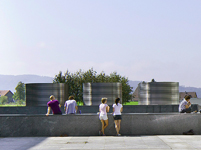Vittorio Lampugnani

Vittorio Magnago Lampugnani, Professor für Geschichte des Städtebaus
Interview with Prof. Vittorio Magnago Lampugnani
by Elke Hodson
Dr. Vittorio Magnago Lampugnani is a professor of the History of Urban Design at ETHZ. His work is incredibly diverse. During his 35 year career, he has been a practicing architect, dean, a museum director, a magazine editor, a curator of international exhibitions, a writer whose work has been translated into many languages, a member of countless advisory boards, a consultant and a prize-winning teacher.
He also has something to say about how the past can teach us about building sustainable cities for the future.
Prof. Lampugnani grew up in Rome, a city known for its historical urban building design, and one which certainly influenced his chosen career path. As a student, his academic interests were the arts, literature, history and culture, which eventually led him to study architecture.
To gain "a clearer view of what building forms fit with [his] values," he went on to graduate school in the history and theory of architecture, leading to two PhDs in 1977 and 1983 from Stuttgart and Rome Universities, respectively.
Since 1980, Dr. Lampugnani has run an architecture office, originally in Berlin, but more recently based in Milan. He now says that if he did not have both the practical application and academic study he would miss building. "When one builds a house, it is wonderful," Dr. Lampugnani smiles, "building is always beyond your imagination."
Amongst his most important projects are: the entrance square of the Audi factory in Ingolstadt, planning of the Novartis campus in Basel, and most recently, planning for the Richi Quartier in Wallisellen.
In 2009, Prof. Lampugnani was awarded the Golden Owl, ETHZ's highest teaching award, for teaching the history of urban design. How does he make a history class interesting? Prof. Lampugnani has designed his classes to be more project-based.
"Students," he reflects, "are interested in tools for designing." When he can relate the tools, which architects of the past used to create a modern-day Paris, for example, he captures student interest. "We look at history like a series of projects and relate historical to contemporary projects."
What is the best way to create a sustainable city? "Rational planning," states Dr. Lampugnani, "planning is one of the major instruments for being sustainable. Historically cities have always tried to be sustainable: all buildings had to deal intelligently with their environment."
He discourages thinking about sustainability in mono-thematic ways, such as the Minergy or LEED building certifications; which often view reducing building energy usage as the primary goal, regardless of what this means for the indoor climate quality of the house or how much this increases use of potentially hazardous insulation materials. Asbestos is a prominent example of a ubiquitous insulation material, which was later found to be carcinogenic.
It also does no good, Dr. Lampugnani notes, to build a Minergy house in a place far from public transportation, where multiple personal cars are necessary. "We haven't put the data together. We need to look beyond the house to the entire territory [to assess building sustainability]," he concludes.









